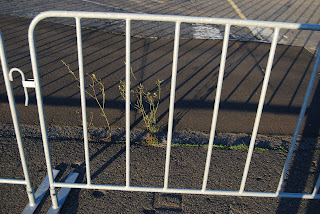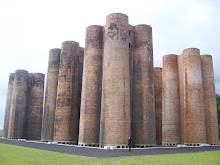
The Urban Wildlife Safari took place on Saturday October 9th as part of the exhibition In The Balance: Art for a Changing World. The public walk offered a new way of looking at nature in the city and observed how wildlife, both flora and fauna, maintains its presence in the built environment of Sydney’s CBD. The idea came about as a way to find the uncontrolled and untamed elements of urban nature, not the cultivated or the park variety. While these man-made spaces do all add to the greening of a city, it was more interesting to look for new urban ecologies that develop regardless and in spite of human intentions.
The walk began at the front lawn of the MCA, where hand painted maps of our route designed by Norbert Walczak were distributed .

click to enlarge
Our first guide was artist Diego Bonetto who took us up through The Rocks pointing out the “spontaneous flora” (otherwise known as weeds) that grew in and around the Argyle Cut. It was interesting to see that while the Celtis trees had been cut down at Circular Quay, some new shoots were already sprouting in a small park nearby. Another surprise was a tomato plant, taking root after being discarded perhaps in an office workers salad sandwich.




The Argle Cut itself is a man-made tunnel created out of sandstone in 1868 to link the 2 early ports of Sydney. Here on the cut rockface, plants such as Lantana take advantage of the water seeping from the walls and take root in hard to reach places, creating a beautiful natural vertical garden and an ecology that could not be replicated by design.
The group followed Argyle Street up through the cut and to the Munn street reserve, overlooking the soon to be developed Barangaroo foreshore. Helen Armstrong, who was one of the original landscape architects for both the Munn and Clyne Street reserves, spoke about the history of the area and the relationship of the parks to the land’s natural contours as well as to the surrounding housing . The area around Barangaroo is about to undergo massive change, for both the community and the landscape.



The Palisade Hotel (1916) is undergoing renovation but still managed to support some plantlife – a very hardy Conyza Canadens was spotted growing from an unfinished building end!

A key issue to explore in this area was the seemingly empty, large post-industrial space of Barangaroo, however we did spot wildlife that had made its habitat there. While many of the birds, such as the Rainbow Lorikeets and Pigeons were attracted to the two park areas, they also tended to forage in the residual spaces around the former container wharfs. Plants were especially abundant in the no go areas, fenced off or out of reach up on the rocky outcrops.





We reached the city via Hickson Road (the Hungry Mile), where the asphalt was being ripped up by the aggressive roots of the Plane trees.



Once in a small green oasis in the heart of the CBD (Lang Park), we were treated to a talk about the bird life in the city with our bird expert and guide Chris Lloyd. While Chris spoke we witnessed the ornithological life amongst us, like Mynas, Magpies, Pigeons and Seagulls. Down at Circular Quay there was an abundance of Ibis and Seagulls, attracted more to human waste than their native food.



Peggy Eby then introduced us to the habitats of the much loved flying foxes, which we observed up close in their colony in the Botanical Gardens. Of course all sydneysiders are entranced by the nightly spectacle of the flying foxes on their way to their feeding locations , most often in the gardens that we plant. Peggy explained that it is ironically our love of planting native gardens and flowering fruit trees that attract the animals, which are consequently now being considered a pest.



In a fitting conclusion to the day, that reminded us of the wildlife that grew throughout Sydney before the building of the city even began, John Lennis , a Dhawral man, introduced us to the bushtucker found in the Sydney region. The walkers were treated to a tasting session of native plums and limes, mystery fruit, and warrigal green pesto and wattle pancakes.





Thank you to all the speakers and participants.
Species list coming soon!


Lots of tourist visit this place, and have fun and in their own style.
ReplyDeleteSafari Consultant
Great information! It looks like this place is full with the tourist,thanks for sharing about it would love to visit here.
ReplyDeleteWildlife Safari
Excellent, Positive site, where u come up with the information on this posting? I have read a lot of the articles on your website now, and I really like your style. I think this kind of blog really helps Audience.
ReplyDeleteWildlife Safari parks
Bandhavgarh National Park Booking
Periyar Wildlife Sanctuary Booking
Satpura National Park Safari Timings
Manas Wildlife Sanctuary Safari Timings
Ranthambore National Park Booking
Jim Corbett Safari Timings
Kanha National Park Booking
Kaziranga National Park Safari
Sunderban National Park Safari